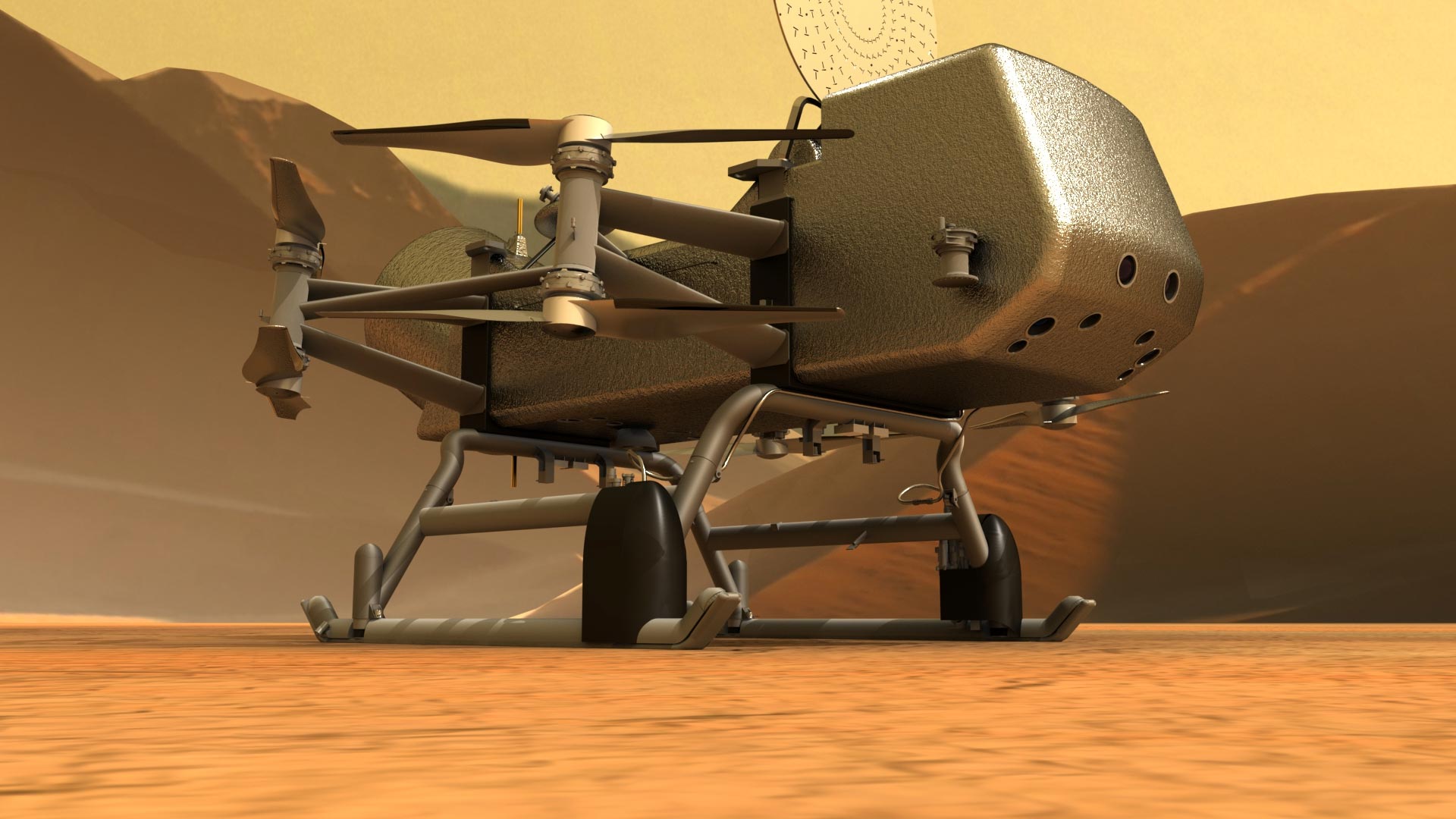
Impressão artística de uma libélula na superfície de Titã. Aproveitando a atmosfera densa e a baixa gravidade de Titã, o Dragonfly explorará dezenas de locais em todo o mundo gelado, amostrando e medindo as composições dos materiais orgânicos da superfície de Titã para determinar a habitabilidade do ambiente de Titã e investigar a evolução de sua química prebiótica. Crédito: NASA/Johns Hopkins APL
novo[{” attribute=””>NASA mission to Saturn’s giant moon, Titan, is due to launch in 2027. When it arrives in the mid-2030s, it will begin a journey of discovery that could bring about a new understanding of the development of life in the universe. This mission, called Dragonfly, will carry an instrument called the Dragonfly Mass Spectrometer (DraMS), designed to help scientists hone in on the chemistry at work on Titan. It may also shed light on the kinds of chemical steps that occurred on Earth that ultimately led to the formation of life, called prebiotic chemistry.
Titan’s abundant complex carbon-rich chemistry, interior ocean, and past presence of liquid water on the surface make it an ideal destination to study prebiotic chemical processes and the potential habitability of an extraterrestrial environment.
DraMS will allow scientists back on Earth to remotely study the chemical makeup of the Titanian surface. “We want to know if the type of chemistry that could be important for early pre-biochemical systems on Earth is taking place on Titan,” explains Dr. Melissa Trainer of NASA’s Goddard Space Flight Center, Greenbelt, Maryland.

This illustration shows NASA’s Dragonfly rotorcraft-lander approaching a site on Saturn’s exotic moon, Titan. Credit: Johns Hopkins/APL
Trainer is a planetary scientist and astrobiologist who specializes in Titan and is one of the Dragonfly mission’s deputy principal investigators. She is also lead on the DraMS instrument, which will scan through measurements of samples from Titan’s surface material for evidence of prebiotic chemistry.
To accomplish this, the Dragonfly robotic rotorcraft will capitalize on Titan’s low gravity and dense atmosphere to fly between different points of interest on Titan’s surface, spread as far as several miles apart. This allows Dragonfly to relocate its entire suite of instruments to a new site when the previous one has been fully explored, and provides access to samples in environments with a variety of geologic histories.
At each site, samples less than a gram in size will be drilled out of the surface by the Drill for Acquisition of Complex Organics (DrACO) and brought inside the lander’s main body, to a place called the “attic” that houses the DraMS instrument. There, they will be irradiated by an onboard laser or vaporized in an oven to be measured by DraMS. A mass spectrometer is an instrument that analyzes the various chemical components of a sample by separating these components down into their base molecules and passing them through sensors for identification.

The colorful globe of Saturn’s largest moon, Titan, passes in front of the planet and its rings in this true color snapshot from NASA’s Cassini spacecraft. Credit: NASA/JPL-Caltech/Space Science Institute
“DraMS is designed to look at the organic molecules that may be present on Titan, at their composition and distribution in different surface environments,” says Trainer. Organic molecules contain carbon and are used by all known forms of life. They are of interest in understanding the formation of life because they can be created by living and non-living processes.
Mass spectrometers (see video below) determine what’s in a sample by ionizing the material (that is, bombarding it with energy so that the atoms therein become positively or negatively charged) and examining the chemical composition of the various compounds. This involves determining the relationship between the weight of the molecule and its charge, which serves as a signature for the compound.
O que você faz se tiver uma amostra de outro planeta e quiser saber se ela contém uma molécula específica… talvez até mesmo uma que revele que o planeta pode sustentar a vida? Diante de uma situação como essa, os cientistas usam uma ferramenta maravilhosa: o espectrômetro de massa. Ele faz o trabalho duro de separar o material, permitindo que os cientistas observem de perto uma amostra e vejam o que há dentro. Saiba mais sobre este instrumento neste vídeo da Divisão de Exploração do Sistema Solar da NASA Goddard.
DraMS é desenvolvido em parte pela mesma equipe da Goddard que desenvolveu Análise de amostra em Marte (SAM) a bordo do rover Curiosity. O DraMS foi projetado para escanear amostras do material da superfície de Titanian No localusando tecnologias comprovadas[{” attribute=””>Mars with the SAM suite.
Trainer emphasized the benefits of this heritage. Dragonfly’s scientists did not want to “reinvent the wheel” when it came to searching for organic compounds on Titan, and instead built on established methods that have been applied on Mars and elsewhere. “This design has given us an instrument that’s very flexible, that can adapt to the different types of surface samples,” says Trainer.
DraMS and other science instruments on Dragonfly are being designed and built under the direction of the Johns Hopkins Applied Physics Laboratory in Laurel, Maryland, which manages the mission for NASA and is designing and building the rotorcraft-lander. The team includes key partners at Goddard, the French space agency (CNES, Paris, France), which is providing the Gas Chromatograph Module for DraMS that will provide an additional separation after leaving the oven, Lockheed Martin Space, Littleton, Colorado, NASA Ames Research Center at Moffett Federal Airfield in California’s Silicon Valley, NASA Langley Research Center, Hampton, Virginia, NASA Jet Propulsion Laboratory, Pasadena, California, Penn State University, State College, Pennsylvania, Malin Space Science Systems, San Diego, California, Honeybee Robotics, Brooklyn, New York, the German Aerospace Center (DLR), Cologne, Germany, and the Japan Aerospace Exploration Agency (JAXA), Tokyo, Japan.
Dragonfly is the fourth mission in NASA’s New Frontiers program. New Frontiers is managed by NASA’s Marshall Space Flight Center in Huntsville, Alabama, for the agency’s Science Mission Directorate Washington.

“Criador. Viciado em mídia social que gosta de hipster. Fã da web. Fanático por álcool apaixonado.”











More Stories
A Boeing pode não conseguir operar o veículo Starliner antes que a estação espacial seja destruída
Vivendo com ansiedade: conselhos de especialistas sobre como aceitar um problema de saúde mental
Nova pesquisa sobre uma enorme falha de impulso sugere que o próximo grande terremoto pode ser iminente